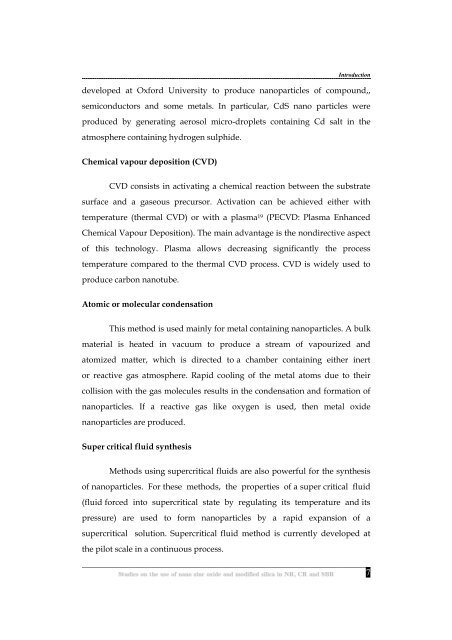Studies on the use of nano zinc oxide and modified silica in NR, CR ...
Studies on the use of nano zinc oxide and modified silica in NR, CR ...
Studies on the use of nano zinc oxide and modified silica in NR, CR ...
You also want an ePaper? Increase the reach of your titles
YUMPU automatically turns print PDFs into web optimized ePapers that Google loves.
Introducti<strong>on</strong><br />
developed at Oxford University to produce <strong>nano</strong>particles <strong>of</strong> compound,,<br />
semic<strong>on</strong>ductors <strong>and</strong> some metals. In particular, CdS <strong>nano</strong> particles were<br />
produced by generat<strong>in</strong>g aerosol micro-droplets c<strong>on</strong>ta<strong>in</strong><strong>in</strong>g Cd salt <strong>in</strong> <strong>the</strong><br />
atmosphere c<strong>on</strong>ta<strong>in</strong><strong>in</strong>g hydrogen sulphide.<br />
Chemical vapour depositi<strong>on</strong> (CVD)<br />
CVD c<strong>on</strong>sists <strong>in</strong> activat<strong>in</strong>g a chemical reacti<strong>on</strong> between <strong>the</strong> substrate<br />
surface <strong>and</strong> a gaseous precursor. Activati<strong>on</strong> can be achieved ei<strong>the</strong>r with<br />
temperature (<strong>the</strong>rmal CVD) or with a plasma 19 (PECVD: Plasma Enhanced<br />
Chemical Vapour Depositi<strong>on</strong>). The ma<strong>in</strong> advantage is <strong>the</strong> n<strong>on</strong>directive aspect<br />
<strong>of</strong> this technology. Plasma allows decreas<strong>in</strong>g significantly <strong>the</strong> process<br />
temperature compared to <strong>the</strong> <strong>the</strong>rmal CVD process. CVD is widely <strong>use</strong>d to<br />
produce carb<strong>on</strong> <strong>nano</strong>tube.<br />
Atomic or molecular c<strong>on</strong>densati<strong>on</strong><br />
This method is <strong>use</strong>d ma<strong>in</strong>ly for metal c<strong>on</strong>ta<strong>in</strong><strong>in</strong>g <strong>nano</strong>particles. A bulk<br />
material is heated <strong>in</strong> vacuum to produce a stream <strong>of</strong> vapourized <strong>and</strong><br />
atomized matter, which is directed to a chamber c<strong>on</strong>ta<strong>in</strong><strong>in</strong>g ei<strong>the</strong>r <strong>in</strong>ert<br />
or reactive gas atmosphere. Rapid cool<strong>in</strong>g <strong>of</strong> <strong>the</strong> metal atoms due to <strong>the</strong>ir<br />
collisi<strong>on</strong> with <strong>the</strong> gas molecules results <strong>in</strong> <strong>the</strong> c<strong>on</strong>densati<strong>on</strong> <strong>and</strong> formati<strong>on</strong> <strong>of</strong><br />
<strong>nano</strong>particles. If a reactive gas like oxygen is <strong>use</strong>d, <strong>the</strong>n metal <strong>oxide</strong><br />
<strong>nano</strong>particles are produced.<br />
Super critical fluid syn<strong>the</strong>sis<br />
Methods us<strong>in</strong>g supercritical fluids are also powerful for <strong>the</strong> syn<strong>the</strong>sis<br />
<strong>of</strong> <strong>nano</strong>particles. For <strong>the</strong>se methods, <strong>the</strong> properties <strong>of</strong> a super critical fluid<br />
(fluid forced <strong>in</strong>to supercritical state by regulat<strong>in</strong>g its temperature <strong>and</strong> its<br />
pressure) are <strong>use</strong>d to form <strong>nano</strong>particles by a rapid expansi<strong>on</strong> <strong>of</strong> a<br />
supercritical soluti<strong>on</strong>. Supercritical fluid method is currently developed at<br />
<strong>the</strong> pilot scale <strong>in</strong> a c<strong>on</strong>t<strong>in</strong>uous process.<br />
7

















